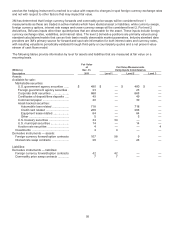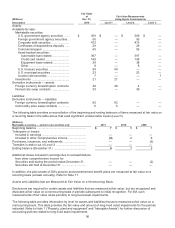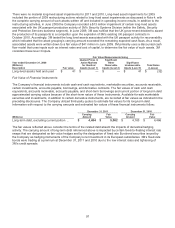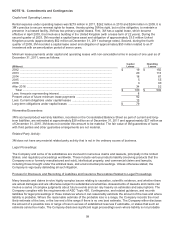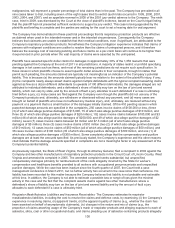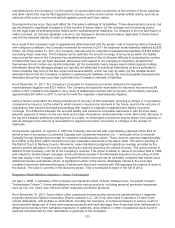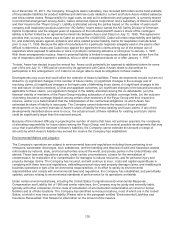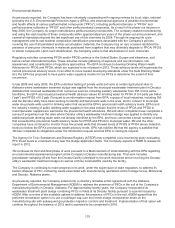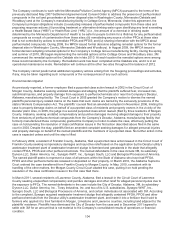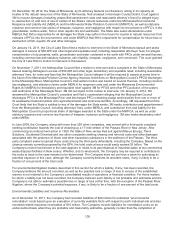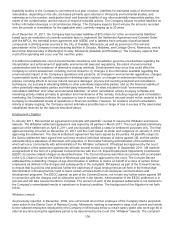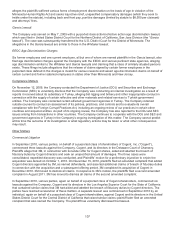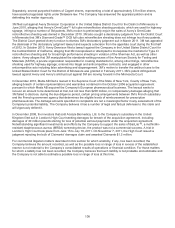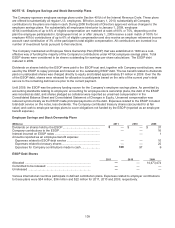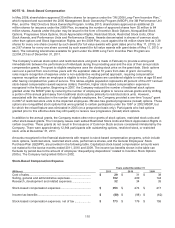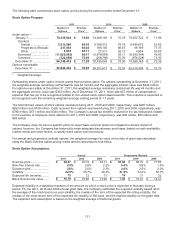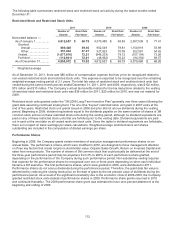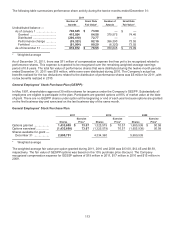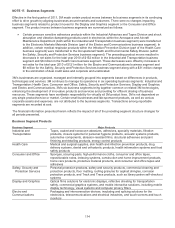3M 2011 Annual Report Download - page 110
Download and view the complete annual report
Please find page 110 of the 2011 3M annual report below. You can navigate through the pages in the report by either clicking on the pages listed below, or by using the keyword search tool below to find specific information within the annual report.
104
The Company continues to work with the Minnesota Pollution Control Agency (MPCA) pursuant to the terms of the
previously disclosed May 2007 Settlement Agreement and Consent Order to address the presence of perfluorinated
compounds in the soil and groundwater at former disposal sites in Washington County, Minnesota (Oakdale and
Woodbury) and at the Company’s manufacturing facility in Cottage Grove, Minnesota. Under this agreement, the
Company’s principal obligations include (i) evaluating releases of perfluorinated compounds from these sites and
proposing response actions; (ii) providing treatment or alternative drinking water upon identifying any level exceeding
a Health Based Value (“HBV”) or Health Risk Limit (“HRL”) (i.e., the amount of a chemical in drinking water
determined by the Minnesota Department of Health to be safe for people to drink for a lifetime) for any perfluorinated
compounds as a result of contamination from these sites; (iii) remediating any source of other PFCs at these sites
that is not controlled by actions to remediate PFOA and PFOS; and (iv) sharing information with the MPCA about
perfluorinated compounds. During 2008, the MPCA issued formal decisions adopting remedial options for the former
disposal sites in Washington County, Minnesota (Oakdale and Woodbury). In August 2009, the MPCA issued a
formal decision adopting remedial options for the Company’s Cottage Grove manufacturing facility. During the spring
and summer of 2010, 3M began implementing the remedial options at the Cottage Grove and Woodbury sites. 3M
commenced the remedial option at the Oakdale site in late 2010. At each location the remedial options were among
those recommended by the Company. Remediation work has been completed at the Oakdale site, and it is in an
operational maintenance mode. Remediation will continue at the other two sites throughout the balance of 2012.
The Company cannot predict what additional regulatory actions arising from the foregoing proceedings and activities,
if any, may be taken regarding such compounds or the consequences of any such actions.
Environmental Litigation
As previously reported, a former employee filed a purported class action lawsuit in 2002 in the Circuit Court of
Morgan County, Alabama seeking unstated damages and alleging that the plaintiffs suffered fear, increased risk,
subclinical injuries, and property damage from exposure to perfluorochemicals at or near the Company’s Decatur,
Alabama, manufacturing facility. The Circuit Court in 2005 granted the Company’s motion to dismiss the named
plaintiff’s personal injury-related claims on the basis that such claims are barred by the exclusivity provisions of the
state’s Workers Compensation Act. The plaintiffs’ counsel filed an amended complaint in November 2006, limiting the
case to property damage claims on behalf of a purported class of residents and property owners in the vicinity of the
Decatur plant. Also, in 2005, the judge in a second purported class action lawsuit (filed by three residents of Morgan
County, Alabama, seeking unstated compensatory and punitive damages involving alleged damage to their property
from emissions of perfluorochemical compounds from the Company’s Decatur, Alabama, manufacturing facility that
formerly manufactured those compounds) granted the Company’s motion to abate the case, effectively putting the
case on hold pending the resolution of class certification issues in the first action described above filed in the same
court in 2002. Despite the stay, plaintiffs filed an amended complaint seeking damages for alleged personal injuries
and property damage on behalf of the named plaintiffs and the members of a purported class. No further action in the
case is expected unless and until the stay is lifted.
In February 2009, a resident of Franklin County, Alabama, filed a purported class action lawsuit in the Circuit Court of
Franklin County seeking compensatory damages and injunctive relief based on the application by the Decatur utility’s
wastewater treatment plant of wastewater treatment sludge to farmland and grasslands in the state that allegedly
contain PFOA, PFOS and other perfluorochemicals. The named defendants in the case include 3M, its subsidiary
Dyneon LLC, Daikin America, Inc., Synagro-WWT, Inc., Synagro South, LLC and Biological Processors of America.
The named plaintiff seeks to represent a class of all persons within the State of Alabama who have had PFOA,
PFOS and other perfluorochemicals released or deposited on their property. In March 2010, the Alabama Supreme
Court ordered the case transferred from Franklin County to Morgan County. In May, 2010, consistent with its
handling of the other matters, the Morgan County Circuit Court abated this case, putting it on hold pending the
resolution of the class certification issues in the first case filed there.
In March 2011, several residents of Lawrence County, Alabama, filed a lawsuit in the Circuit Court of Lawrence
County seeking unspecified compensatory and punitive damages and other relief for alleged personal injuries due to
the exposure to PFCs. The named defendants in the case include the City of Decatur, Alabama, 3M, its subsidiary
Dyneon LLC, Daikin America, Inc., Toray Industries, Inc. and two of its U.S. subsidiaries, Synagro-WWT, Inc.,
Synagro South, LLC and Biological Processors of America, and certain individuals not associated with 3M. According
to the complaint, Synagro acquired wastewater treatment sludge that allegedly contained PFOA, PFOS and other
perfluorochemicals from the Decatur utility’s wastewater treatment plant, and made it into a fertilizer that it sold to
farmers who applied it to their farmland in Morgan, Limestone and Lawrence counties, including land adjacent to the
plaintiffs’ residence. Plaintiffs have dismissed the City of Decatur from the case and in December 2011 agreed to
settle with 3M for an amount that is not material to the Company’s consolidated results of operations or financial
condition.



